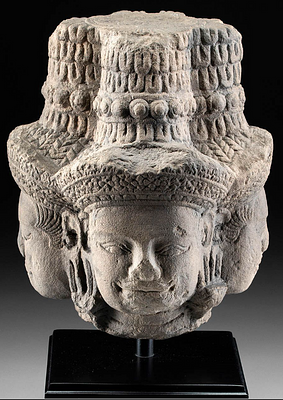Rare 19th C. Yupik Wood Spirit Mask (Nepcetaq)
Lot 120a
About Seller
Artemis Fine Arts
686 S Taylor Ave, Ste 106
Louisville, CO 80027
United States
Selling antiquities, ancient and ethnographic art online since 1993, Artemis Gallery specializes in Classical Antiquities (Egyptian, Greek, Roman, Near Eastern), Asian, Pre-Columbian, African / Tribal / Oceanographic art. Our extensive inventory includes pottery, stone, metal, wood, glass and textil...Read more
Categories
Estimate:
$10,000 - $15,000
Absentee vs Live bid
Two ways to bid:
- Leave a max absentee bid and the platform will bid on your behalf up to your maximum bid during the live auction.
- Bid live during the auction and your bids will be submitted real-time to the auctioneer.
Bid Increments
| Price | Bid Increment |
|---|---|
| $0 | $25 |
| $300 | $50 |
| $1,000 | $100 |
| $2,000 | $250 |
| $5,000 | $500 |
| $10,000 | $1,000 |
| $20,000 | $2,500 |
| $50,000 | $5,000 |
| $100,000 | $10,000 |
| $200,000 | $20,000 |
About Auction
By Artemis Fine Arts
Jun 29, 2023
Set Reminder
2023-06-29 10:00:00
2023-06-29 10:00:00
America/New_York
Bidsquare
Bidsquare : Exceptional Antiquities, Ethnographic and Fine Art
https://www.bidsquare.com/auctions/artemis-gallery/exceptional-antiquities-ethnographic-and-fine-art-13031
Artemis Fine Arts info@artemisgallery.com
Artemis Fine Arts info@artemisgallery.com
- Lot Description
Native American, Northwestern United States, Alaska, Yup'ik culture, ca. late 19th to early 20th century CE. A fantastical wooden spirit mask known as a Nepcetaq (Nepcetat) with waterfowl feathers (possibly snow goose or swan) and rawhide cords on the verso. This type of mask was usually made under the guidance of a shaman, or by the shaman, and worn during rituals and dances. The semi-human spirits known as (tuunraq) tuunrat were sometimes said to live on the moon - symbolized by the round face- and acted like game wardens. The masked rituals honored the spirits and animals to ensure successful hunts; a harmonious relationship with the animals is a crucial part of their culture and religion. The face has sharp bone teeth set into the grinning mouth, and relief seals are carved into the panel surface, the large holes might represent the ice holes that the seals emerged from and the movement between worlds. Size w/ feathers: 12.5" L x 2" W x 19" H (31.8 cm x 5.1 cm x 48.3 cm)
A similar mask is on display at the Fenimore Art Museum, object number: T0231. For additional information about this type of mask please see the article by Dr. Lauren Kilroy-Ewbank, "North Wind Mask" on the Smarthistory website, published August 22, 2016.
Provenance: private West Jordon, Utah, USA collection; ex-Dr.Wilson Kern collection, acquired in Kenai, Alaska, USA in 1905
All items legal to buy/sell under U.S. Statute covering cultural patrimony Code 2600, CHAPTER 14, and are guaranteed to be as described or your money back.
A Certificate of Authenticity will accompany all winning bids.
We ship worldwide and handle all shipping in-house for your convenience.
#178538Stable pressure fissures to wood as shown. Minor surface nicks, otherwise intact. Fraying to feathers.Condition
- Shipping Info
-
All shipping is handled in-house for your convenience. Your invoice from Artemis Gallery will include shipping calculation instructions. If in doubt, please inquire BEFORE bidding for estimated shipping costs for individual items.
-
- Buyer's Premium



 EUR
EUR CAD
CAD AUD
AUD GBP
GBP MXN
MXN HKD
HKD CNY
CNY MYR
MYR SEK
SEK SGD
SGD CHF
CHF THB
THB













